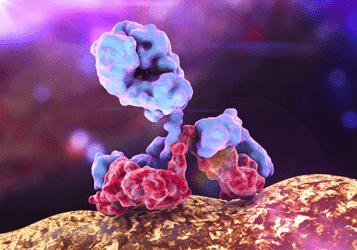- Home
- Products
- Customized ADCs
- EpCAM
- Anti-EPCAM (Adecatumumab)-SPDB-DM4 ADC
Anti-EPCAM (Adecatumumab)-SPDB-DM4 ADC (CAT#: ADC-W-1071)
This ADC product is comprised of an anti-EPCAM monoclonal antibody conjugated via a SPDB linker to DM4. The DM4 is targeted to certain cancers by immunerecognition and delivered into cancer cells via receptor mediated endocytosis. Within the cell, DM1 binds to tubulins, interrupts microtubule dynamics, and subsequently, induces cell death.
- ADC Target
- ADC Antibody
- ADC Linker
- ADC payload drug
- Name
- EpCAM
- Alternative Names
- EPCAM; epithelial cell adhesion molecule; antigen identified by monoclonal AUA1 , M4S1, MIC18, TACSTD1, tumor associated calcium signal transducer 1; 17 1A; 323/A3; CD326; CO 17A; EGP 2; EGP34; EGP40; Ep CAM; ESA; GA733 2; HEA125; KS1/4; KSA; Ly74; MH99; MK 1; MOC31; TACST 1; TROP1; epithelial glycoprotein 314; human epithelial glycoprotein-2; cell surface glycoprotein Trop-1; adenocarcinoma-associated antigen; tumor-associated calcium signal transducer 1; major gastrointestinal tumor-associated protein GA733-2; membrane component, chromosome 4, surface marker (35kD glycoprotein); M4S1; MK-1; DIAR5; EGP-2; MIC18; EGP314; HNPCC8; TACSTD1; GA733-2;
- Target Entrez Gene ID
- 4072
- Target UniProt ID
- P16422
- Overview
- This gene encodes a carcinoma-associated antigen and is a member of a family that includes at least two type I membrane proteins. This antigen is expressed on most normal epithelial cells and gastrointestinal carcinomas and functions as a homotypic calcium-independent cell adhesion molecule. The antigen is being used as a target for immunotherapy treatment of human carcinomas. Mutations in this gene result in congenital tufting enteropathy.
- Overview
- Human Anti-EpCAM IgG1 antibody, Adecatumumab
- Generic name
- Adecatumumab
- Host animal
- Human
- Species Reactivity
- Human
- Name
- SPDB (N-succinimidyl-4-(2-pyridyldithio)butyrate)
- Description
- Disulfide Linkers, are extensively exploited as a chemically labile linkage. Since the release of disulfide-linked drugs requires a cytoplasmic thiol cofactor, such as glutathione (GSH). Disulfides maintain stable at physiological pH and only when ADCs are internalized inside cells, the cytosol provides reducing environment including intracellular enzyme protein disulfide isomerase, or similar enzymes, drugs can be released.
- Name
- DM4 (N2'-Deacetyl-N2'-(4-mercapto-4-methyl-1-oxopentyl)maytansine)
- Description
- Derived from Maytansinoid,a group of cytotoxins structurally similar to rifamycin, geldanamycin, and ansatrienin. The eponymous natural cytotoxic agent maytansine is a 19-member lactam (ansa macrolide) structure originally isolated from the Ethiopian shrub Maytenus ovatus. Maytansinoids can bind to tubulin at or near the vinblastine-binding site, which interfere the formation of microtubules and depolymerize already formed microtubules, inducing mitotic arrest in the intoxicated cells.
For Research Use Only. NOT FOR CLINICAL USE.
Related Products
- Anti-VEGFA (Vanucizumab)-MC-Vc-PAB-DMEA-(PEG2)-duocarmycin SA ADC (CAT#: ADC-W-2293)
- Anti-MUC1 (Cantuzumab )-MC-Vc-PAB-MMAE ADC (CAT#: ADC-W-1613)
- Anti-IL2RA (Basiliximab)-SMCC-DM1 ADC (CAT#: ADC-W-1364)
- Anti-CD248 (Ontuxizumab)-MC-MMAF ADC (CAT#: ADC-W-808)
- Anti-IgE Fc (Talizumab)-MC-Vc-PAB-SN38 ADC (CAT#: ADC-W-2154)
- Anti-OxLDL-MC-Vc-PAB-SN38 ADC (CAT#: ADC-W-2094)
- Anti-IAV HA (Diridavumab(CR6261))-MC-MMAF ADC (CAT#: ADC-W-2068)
- Anti-ERBB2 (Margetuximab)-MC-Vc-PAB-SN38 ADC (CAT#: ADC-W-1110)
- Anti-ITGAV (Intetumumab)-SPDB-DM4 ADC (CAT#: ADC-W-1491)
- Anti-CD248 (Ontuxizumab)-SPDB-DM4 ADC (CAT#: ADC-W-807)
Published Data
+ Submit Publications

Scientific Resources
Customer Reviews and FAQs
There are currently no Customer reviews or questions for ADC-W-1071. Click the button above to contact us or submit your feedback about this product.
Quick Links
Other Products
Same Target
Same Linker
Same Payload
| CAT# | Product Name | Linker | Payload |
| ADC-W-1086 | Anti-EPCAM (Tucotuzumab)-MC-Vc-PAB-SN38 ADC | MC-Vc-PAB (maleimidocaproyl-valine-citrulline-p-aminobenzoyloxycarbonyl) | SN-38 (7-ethyl-10-hydroxycamptothecin) |
| ADC-W-1082 | Anti-EPCAM (Tucotuzumab)-SMCC-DM1 ADC | SMCC (N-succinimidyl 4-(Nmaleimidomethyl)cyclohexane-1-carboxylate) | DM1 (N2'-Deacetyl-N2'-(3-mercapto-1-oxopropyl)maytansine) |
| ADC-W-1079 | Anti-EPCAM (Citatuzumab bogatox)-MC-Vc-PAB-MMAE ADC | MC-Vc-PAB (maleimidocaproyl-valine-citrulline-p-aminobenzoyloxycarbonyl) | MMAE |
| ADC-W-1099 | Anti-EPCAM (Edrecolomab)-MC-Vc-PAB-DMEA-(PEG2)-duocarmycin SA ADC | MC-Vc-PAB-DMEA-(PEG2) | duocarmycin SA |
| ADC-W-1080 | Anti-EPCAM (Citatuzumab bogatox)-MC-Vc-PAB-SN38 ADC | MC-Vc-PAB (maleimidocaproyl-valine-citrulline-p-aminobenzoyloxycarbonyl) | SN-38 (7-ethyl-10-hydroxycamptothecin) |
| CAT# | Product Name | Linker | Payload |
| ADC-W-516 | Anti-FOLR1-SPDB-DM4 ADC-5 | SPDB (N-succinimidyl-4-(2-pyridyldithio)butyrate) | DM4 (N2'-Deacetyl-N2'-(4-mercapto-4-methyl-1-oxopentyl)maytansine) |
| ADC-W-320 | Anti-SDC1-SPDB-DM4 ADC | SPDB (N-succinimidyl-4-(2-pyridyldithio)butyrate) | DM4 (N2'-Deacetyl-N2'-(4-mercapto-4-methyl-1-oxopentyl)maytansine) |
| ADC-W-2605 | Anti-ITGB3 (Tadocizumab)-SPDB-DM4 ADC | SPDB (N-succinimidyl-4-(2-pyridyldithio)butyrate) | DM4 (N2'-Deacetyl-N2'-(4-mercapto-4-methyl-1-oxopentyl)maytansine) |
| ADC-W-324 | Anti-CD19-SPDB-DM4 ADC-3 | SPDB (N-succinimidyl-4-(2-pyridyldithio)butyrate) | DM4 (N2'-Deacetyl-N2'-(4-mercapto-4-methyl-1-oxopentyl)maytansine) |
| ADC-W-2616 | Anti-MS4A1-SPDB-DM4 ADC | SPDB (N-succinimidyl-4-(2-pyridyldithio)butyrate) | DM4 (N2'-Deacetyl-N2'-(4-mercapto-4-methyl-1-oxopentyl)maytansine) |
| CAT# | Product Name | Linker | Payload |
| ADC-W-2621 | Anti-NCAM1 (Lorvotuzumab )-SPDB-DM4 ADC | SPDB (N-succinimidyl-4-(2-pyridyldithio)butyrate) | DM4 (N2'-Deacetyl-N2'-(4-mercapto-4-methyl-1-oxopentyl)maytansine) |
| ADC-W-2599 | Anti-GPNMB (Glembatumumab)-SPDB-DM4 ADC | SPDB (N-succinimidyl-4-(2-pyridyldithio)butyrate) | DM4 (N2'-Deacetyl-N2'-(4-mercapto-4-methyl-1-oxopentyl)maytansine) |
| ADC-W-320 | Anti-SDC1-SPDB-DM4 ADC | SPDB (N-succinimidyl-4-(2-pyridyldithio)butyrate) | DM4 (N2'-Deacetyl-N2'-(4-mercapto-4-methyl-1-oxopentyl)maytansine) |
| ADC-W-516 | Anti-FOLR1-SPDB-DM4 ADC-5 | SPDB (N-succinimidyl-4-(2-pyridyldithio)butyrate) | DM4 (N2'-Deacetyl-N2'-(4-mercapto-4-methyl-1-oxopentyl)maytansine) |
| ADC-W-2616 | Anti-MS4A1-SPDB-DM4 ADC | SPDB (N-succinimidyl-4-(2-pyridyldithio)butyrate) | DM4 (N2'-Deacetyl-N2'-(4-mercapto-4-methyl-1-oxopentyl)maytansine) |
Online Inquiry
Welcome! For price inquiries, please feel free to contact us through the form on the left side. We will get back to you as soon as possible.



